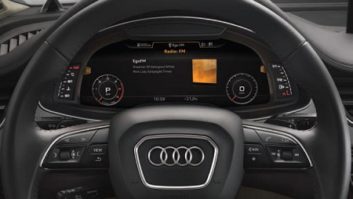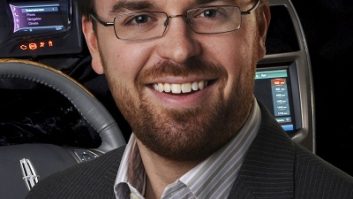The author is president of Jacobs Media, which he founded in 1983.

A montage of images from the Detroit telecommunications conference this year. Radio station operators have had to adjust to a fast-changing kaleidoscope of change throughout the media and technology ecosphere.
From streaming to social media to mobile to new competitive threats, radio’s place in the 21st century media landscape has become far more complex.
But radio could always count on the car. Just about everyone drives, and radio’s ability to provide myriad entertainment and information options in vehicles has been one of its core strengths.
Over the decades, media and technology have threatened radio’s in-car dominance, starting with 8-tracks, cassettes and CDs — the consumer’s first effort at customizing their mobile entertainment. Then came satellite radio, an appealing subscription option for those seeking different content and consumers who spend a great deal of time commuting or driving for a living.
But all the while, radio was relatively safe in the cocoon of the driver’s seat. The “two-knobs-12-presets” standard kept radio locked in as the primary infotainment source for consumers on the road … until now.
CARS MATTER
To appreciate the car’s new importance, consider how often business decisions made by modern-day station managers revolve around the automobile.
First, the lion’s share of broadcast radio listening takes place while driving. And interestingly, this is even more the case for younger generations. While they may avail themselves of music services such as Pandora, Spotify and YouTube while at home, work or school, in-car options have been more limited in scope.
Our Techsurvey9 — the largest study of media and technology for the radio industry — clearly shows the importance of cars on overall listening. Our Techsurveys explore technology preferences among people who actively use radio. More than half of the latest sample reports that all or most of their broadcast radio consumption takes place while driving, especially Millennials or Gen Y.
Another consideration is that the automotive sector continues to be a primary source of advertising revenue for radio. In fact, for many stations, clusters and companies, it remains the top sector, albeit challenged by upstarts that directly connect consumers via search and more granular metrics.
The last offshoot of this is telematics, offering exciting initiatives by every automaker and Tier 1 supplier to redefine the infotainment offerings in cars. The “connected car” is changing the interface between car companies and consumers, including showroom conversations, model selection and transactions.
And while radio broadcasters have always had an innate grasp of in-car entertainment — from strong morning commute shows, traffic and road information, even pushbutton preset strategies — the current state of cars with “digital dash,” and the implications for the radio industry, seem to elude broadcasters at a time when their understanding of this changing space should be growing rather than diminishing.
COUNT YOURSELF IN
This spring in Novi, Mich., Telematics Update held its annual conference, bringing together an enthusiastic group of automotive and media professionals to discuss this ongoing hot topic, “the connected car.” Some 2,000 professionals made the trip to the Detroit metro area.
Sadly, the radio broadcasting industry was not well-represented, aside from Arbitron’s Dr. Ed Cohen, NPR, iBiquity Digital and my company, jacAPPS.
On the other hand, “radio” was represented by a number of companies and brands, including Pandora, Slacker, Aha and SiriusXM (a platinum sponsor). You have to wonder how the automotive companies and Tier 1s at the event interpreted radio’s interest and commitment levels, based on who was, and was not, in attendance.
The automakers are moving ahead on all cylinders, and while each OEM has a different idea of what works, they share similar visions about the value of telematics. Everywhere you went at this conference, you could find more proof that telematics is being driven by content, services and distribution channels — especially the smartphone.
One of the best panels was moderated by Strategy Analytics’ Roger Lanctot, one of the brightest minds at this event. He joined three area auto dealers, along with the head of the Michigan Automotive Dealers Association. This marked the first year that car dealers were invited to participate in these conferences, and it turned out to be a riveting panel.
They spoke of the sometimes-tenuous partnerships they have with the OEMs, much like the network/affiliation relationship in radio. They also noted that dealerships are the true connection point between the auto brands and the consumers. The success of the “connected car” doesn’t rely just on engineers and technologists. As the panelists noted, problems with consumer adoption and education start and stop with their brick-and-mortar local dealerships.
Everywhere you looked at Telematics Detroit 2013, it was about “the connected car.” As suggested by the photo montage (pictured), everyone has a plan, a concept, a platform and a strategy for connecting consumers to their vehicles.
Verizon’s Kevin Link emphasized the difference between following trends as a savvy business decision, and merely being trendy.
In the automotive space, it’s a lot like radio. It’s sometimes difficult to differentiate the fads from the bona fide trends. So he broke down “connected car” components into five silos: safety/security, diagnostics, convenience (key fobs, remote features), navigation and infotainment. And everywhere he looked, all roads lead to …
Infotainment. Content. Programming.
That’s because people don’t walk into dealerships asking about security features or better “check engine light” diagnostics. Instead, they are talking about their mobile entertainment and the features their next car will offer. Embedded modems and smartphone connectivity are at the epicenter of this conversation.
Broadcasters owe it to themselves, their stockholders and stakeholders to immerse themselves in this space. It won’t be long before quarterly investor calls will feature questions that go beyond the future of AM radio, Rush Limbaugh’s antics and political ad spending. Analysts are going to start asking about mobile strategies, connected cars and how companies will handle these challenges moving forward.
Telematics is shaping up to be a bigger and more important of radio’s future. That’s why we attend these conferences. Spurred on by our Techsurveys, we continue to see evidence that it is paramount for broadcast radio to show up, learn and let this industry know we care, we’re engaged, we’re invested and we’re part of this future.
Broadcast radio needs to be here, to become a part of the conversation, and to remind the OEMs and Tier 1s — and the pure-plays — that we were the original in-car content and still are #1 today. But it will take more than broadcasters swooping in and throwing a cocktail party to gain credibility in this emerging space. The industry need to commit to partnerships, an exchange of ideas, dealer initiatives and advertising programs that integrate local retailers.
Next year, put Telematics Detroit 2014 on your conference agenda.












